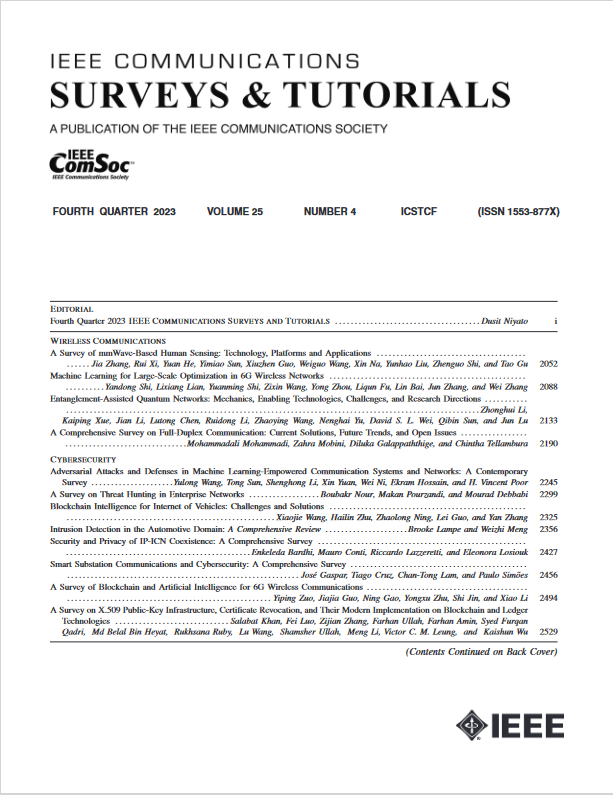Privacy-Preserving Data-Driven Learning Models for Emerging Communication Networks: A Comprehensive Survey
IF 34.4
1区 计算机科学
Q1 COMPUTER SCIENCE, INFORMATION SYSTEMS
引用次数: 0
Abstract
With the proliferation of Beyond 5G (B5G) communication systems and heterogeneous networks, mobile broadband users are generating massive volumes of data that undergo fast processing and computing to obtain actionable insights. While analyzing this huge amount of data typically involves machine and deep learning-based data-driven Artificial Intelligence (AI) models, a key challenge arises in terms of providing privacy assurances for user-generated data. Even though data-driven techniques have been widely utilized for network traffic analysis and other network management tasks, researchers have also identified that applying AI techniques may often lead to severe privacy concerns. Therefore, the concept of privacy-preserving data-driven learning models has recently emerged as a hot area of research to facilitate model training on large-scale datasets while guaranteeing privacy along with the security of the data. In this paper, we first demonstrate the research gap in this domain, followed by a tutorial-oriented review of data-driven models, which can be potentially mapped to privacy-preserving techniques. Then, we provide preliminaries of a number of privacy-preserving techniques (e.g., differential privacy, functional encryption, Homomorphic encryption, secure multi-party computation, and federated learning) that can be potentially adopted for emerging communication networks. The provided preliminaries enable us to showcase the subset of data-driven privacy-preserving models, which are gaining traction in emerging communication network systems. We provide a number of relevant networking use cases, ranging from the B5G core and Radio Access Networks (RANs) to semantic communications, adopting privacy-preserving data-driven models. Based on the lessons learned from the pertinent use cases, we also identify several open research challenges and hint toward possible solutions.新兴通信网络的隐私保护数据驱动学习模型:全面调查
随着超5G (B5G)通信系统和异构网络的普及,移动宽带用户正在生成大量数据,这些数据经过快速处理和计算,以获得可操作的见解。虽然分析这些大量数据通常涉及基于机器和深度学习的数据驱动的人工智能(AI)模型,但在为用户生成的数据提供隐私保证方面出现了一个关键挑战。尽管数据驱动技术已被广泛用于网络流量分析和其他网络管理任务,但研究人员也发现,应用人工智能技术可能经常导致严重的隐私问题。因此,保护隐私的数据驱动学习模型的概念近年来成为研究的热点,以促进大规模数据集上的模型训练,同时保证数据的隐私和安全性。在本文中,我们首先展示了该领域的研究差距,然后对数据驱动模型进行了面向教程的回顾,这些模型可以潜在地映射到隐私保护技术。然后,我们提供了一些隐私保护技术(例如,差分隐私、功能加密、同态加密、安全多方计算和联邦学习)的初步介绍,这些技术可能被用于新兴的通信网络。所提供的初步说明使我们能够展示数据驱动的隐私保护模型的子集,这些模型在新兴的通信网络系统中越来越受到关注。我们提供了许多相关的网络用例,从B5G核心和无线接入网络(ran)到语义通信,采用保护隐私的数据驱动模型。基于从相关用例中获得的经验教训,我们还确定了几个开放的研究挑战,并暗示了可能的解决方案。
本文章由计算机程序翻译,如有差异,请以英文原文为准。
求助全文
约1分钟内获得全文
求助全文
来源期刊

IEEE Communications Surveys and Tutorials
COMPUTER SCIENCE, INFORMATION SYSTEMS-TELECOMMUNICATIONS
CiteScore
80.20
自引率
2.50%
发文量
84
审稿时长
6 months
期刊介绍:
IEEE Communications Surveys & Tutorials is an online journal published by the IEEE Communications Society for tutorials and surveys covering all aspects of the communications field. Telecommunications technology is progressing at a rapid pace, and the IEEE Communications Society is committed to providing researchers and other professionals the information and tools to stay abreast. IEEE Communications Surveys and Tutorials focuses on integrating and adding understanding to the existing literature on communications, putting results in context. Whether searching for in-depth information about a familiar area or an introduction into a new area, IEEE Communications Surveys & Tutorials aims to be the premier source of peer-reviewed, comprehensive tutorials and surveys, and pointers to further sources. IEEE Communications Surveys & Tutorials publishes only articles exclusively written for IEEE Communications Surveys & Tutorials and go through a rigorous review process before their publication in the quarterly issues.
A tutorial article in the IEEE Communications Surveys & Tutorials should be designed to help the reader to become familiar with and learn something specific about a chosen topic. In contrast, the term survey, as applied here, is defined to mean a survey of the literature. A survey article in IEEE Communications Surveys & Tutorials should provide a comprehensive review of developments in a selected area, covering its development from its inception to its current state and beyond, and illustrating its development through liberal citations from the literature. Both tutorials and surveys should be tutorial in nature and should be written in a style comprehensible to readers outside the specialty of the article.
 求助内容:
求助内容: 应助结果提醒方式:
应助结果提醒方式:


